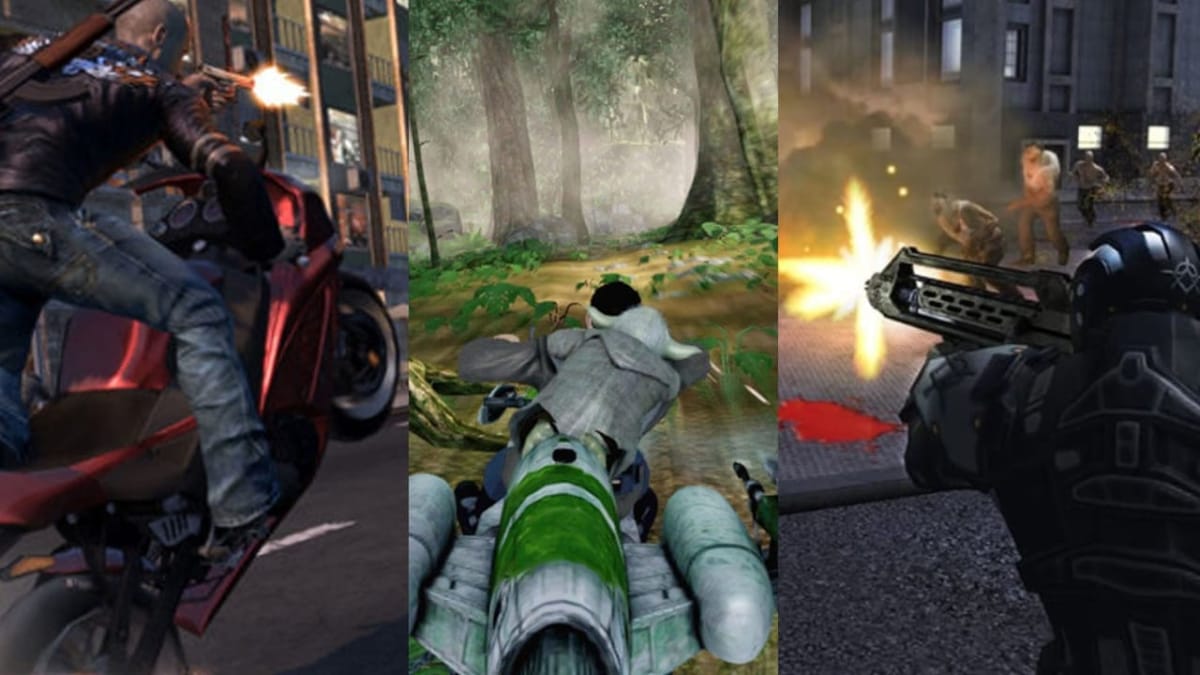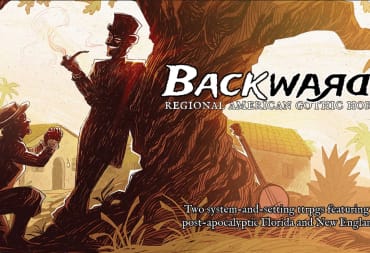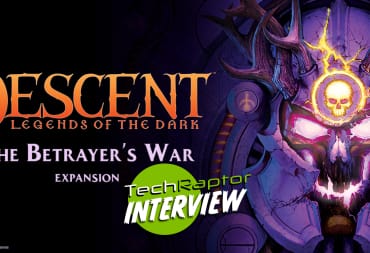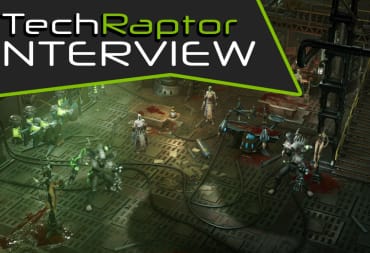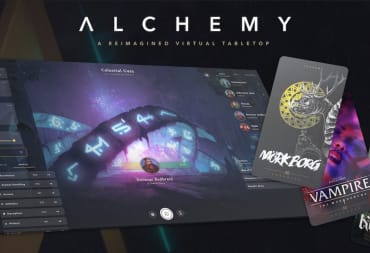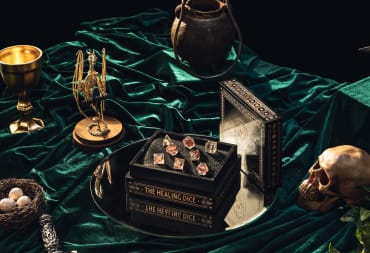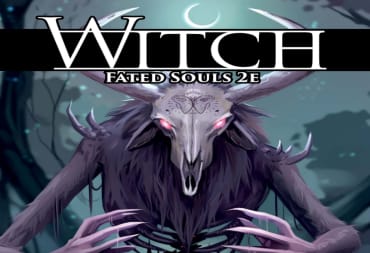Update: To clear up any confusion, this is an unedited transcript of a conversation between me and Sean.
I kind of wondered how long it would be before Sam Speaks would catch me totally off guard. It turns out that answer was on January 16th, when I talked to Sean Noonan. Originally I figured I'd be talking to a fun indie dev behind the cute runner game Jack B. Nimble. Then, a few days before we agreed to chat, I figured maybe I should look into this guy just a tad more. It turns out I had accidentally scheduled an interview with the lead level designer of Splash Damage and had no idea. Sean has had a long and varied career in gaming, so much so that we spent over an hour talking about it and I couldn't reasonably fit it into one article.
So welcome to the first two part episode of Sam Speaks. I got to talk with Sean and the many projects he's worked on. In this part I focus on what got him into professional game creation, his time working at Midway on games like Wheelman and the canceled Necessary Force, and his time working for Ruffian Games where he served as a designer for Crackdown 2 and also worked on the infamous Kinect Star Wars and a canceled Streets of Rage reboot. Strap in, this is a long and interesting one.
TechRaptor: Hello Sean! Thank you for taking the time to talk with me. You have an incredibly long history in video games, to say the least. Why don't we start with what got you into development.
Sean Noonan: Okay. I'm not actually sure on the year, but it's definitely... the first-- basically the first time I ever thought about developing games, other than the aspiration of wanting to make them because I love them as a child, was, I think when Duke Nukem 3D-- it had been out for about a year or two. I think they shipped a new version of it on a disc that had a level editor in it, and it gave me a chance to kind of try things out. This is before I had the internet as well, so I didn't really know where to begin or anything, so I just had to try... just push whatever I could to make things do what I wanted them to do.
I made some stuff. You could call them levels, but I wouldn't say they were good or anything. It was my first steps basically, just learning...I mean, a very outdated interface now, everything is 2D and very abstract looking back then. These levels, I suppose you could call them, there was something about building these spaces that I found quite addictive. Almost more so than playing them, you know? I would jump into the editor, make something that I thought either looked cool or would be cool based on whatever enemy I put in a certain room with a certain gun or something, so I could kind of see how an enemy would react to a certain weapon in a controlled environment. So basically I'd be playing with the AI at that point.
Then, hopefully, which is something I didn't get to really... I wouldn't say I achieved this in Duke Nukem but when I moved up to Half-Life the idea was to mix that testing of the AI and basically pushing the game's mechanics, and then mixing it with the other levels I was making that were just basically artwork. Making nice-looking spaces. So mixing the AI with that and making a cohesive experience, and that's where Half-Life came in. That was a couple years later.
So I guess Duke Nukem, that came out in '96, I would have gotten the editor in about '97 I think? Half-Life came out in '98, so I probably started working on Half-Life maps in 1998 with Worldcraft. They were slightly better. At least they were coherent. At the time I didn't understand flow or, you know, just... there were a lot of strange spaces as well. It was just like there was a logic there, but it wasn't quite... I wasn't quite ready to understand what I was building. It just took time and... yeah. It was probably around when Source was coming in, because at some point I had sort of fallen off, not really knowing weather or not I'd be able to get a job realistically doing this.
So I moved into a completely different field, I was working electronics for a few years. But, meanwhile, Source was picking up and I was looking at it, 'cause Worldcraft became Hammer and that was used for Source as well, so I had some experience with that as well. So yeah, I basically dipped my toe in every so often but didn't really take it completely seriously, but that 'dipping of the toe' should I say, I was building up what was essentially a portfolio and that's actually what got me my first job.
TechRaptor: Now in all this modding, did you ever make maps or mods for Return to Castle Wolfenstein?
Sean: [Laughter.] No, I actually... the funny thing is I really liked Quake and I did very quickly tinker with the Quake editor. I think that might even have used Worldcraft for that, back then, and I didn't really stick with it too much because at the time, and this is kind of blasphemy, I wasn't super into Quake. I liked Doom more. I know that they're both equally great, but these days I must prefer Quake and I love Quake, but at the time I was way into Doom and I had no idea there were editors for Doom or anything there. My internet use was very limited. So yeah.
Basically, I think when Quake 2 came around I wasn't really into Quake 2. Quake 3 came out and I tried the editor, and I had no idea what was going on, and that's what Return to Castle Wolfenstein used and so I basically missed that whole era development-wise. I did play a bunch of these games, there's a lot of Quake 3 engine games I played. But I didn't particularly get on with the editor, so I didn't really work on it unfortunately. Missed that completely.
TechRaptor: Okay, because I just like the idea of you working on mods for Splash Damage's first game and going "boy I'm going to be all these people's boss one day."
Sean: [Laughter.] Yeah, it's funny, I was speaking to my old boss, who left, and I was saying, at the time, like when he started, because he started when the company was first formed, and I said I'm thinking of applying, because I was modding in my time, but I never really got on with the Quake stuff, at least the Quake 3 engine, and I just didn't really feel like I could fill the job. He basically said I would have been in the same boat with a lot of other people at that point, it was just whether or not I would put the foot forward basically.
TechRaptor: So, I'm looking at your portfolio, and its... you've worked on a lot of really interesting games, and I've considered kind of shortening this by company. So you first started, once you got into professional game making, you first started at Midway, with your first professional game being Wheelman. How much of a wake-up call or different experience was that?
Sean: Hmm... So that was quite different because, at that time, and I scold people for this these days when I'm interviewing people, especially people who are newcomers to this industry, who don't know what they're applying for. I basically didn't know what I was applying for when I first applied at Midway. I thought level design and art was the same and that's... that's a real black mark in my book and I was guilty of it when I was a youngin. So it's kind of interesting that I went in there was a very art mindset, but I was actually being hired as a level designer that focused on scripting. So I was going in sort of a mechanical role. That was eye-opening because I've done computing in college but I'm not really... education wasn't my forte, shall I say?
So yeah, even down to what the different variable types were, like I must really have not listened in college because I didn't know the difference between a boolean and an integer or a float or anything. These are little things that are quite quick to learn in practice, but at the time that stuff was quite shocking to me. I just thought I had to shove boxes together and throw paint at it kind of thing, and it was quite... that was a big deal to me.
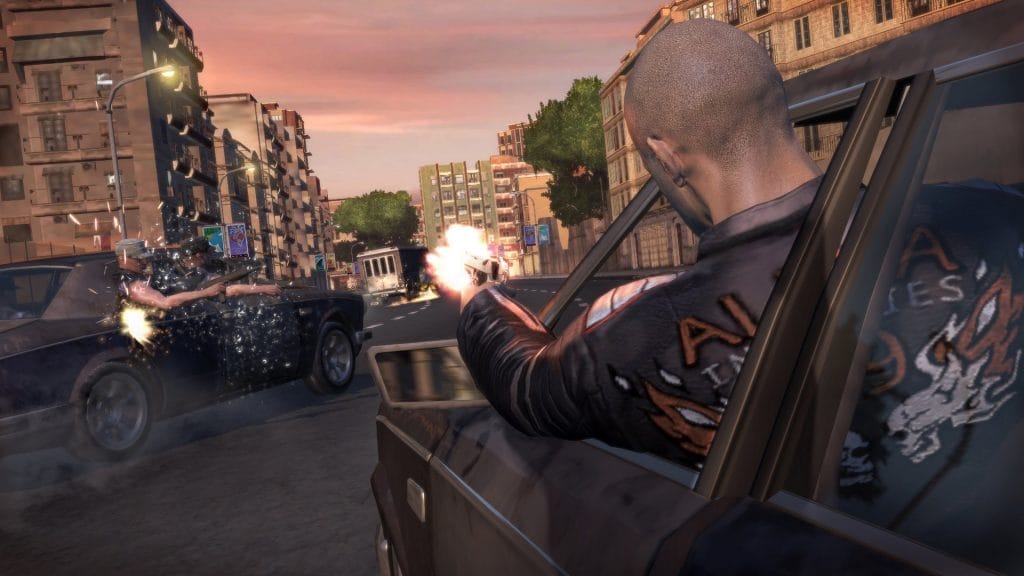
TechRaptor: Most people remember Wheelman probably because it was the game with Vin Diesel in it. By chance, while working on Wheelman, did you ever meet Vin Diesel?
Sean: I did not. A couple of people in the studio did, mostly writers and a couple of producers, but I did not. I was certainly far too low rung for that back then.
TechRaptor: Ah well. Worth checking. So I guess Wheelman was a pretty interesting experience. How much of it would you say you've carried over on the other AAA games you've worked on, or on your personal projects?
Sean: So... It's a weird game because it's not... I guess it's what you call, and I can easily say this in retrospect now looking back on it, what you call a B game quite easily. The way I'm comfortable with that is because its got a lot of interesting ideas, it's just kind of put together in a few... it's definitely missing like some of the polish needed to kind of really sell a whole experience.
But through that those interesting elements, I've kind of latched on to some of them. There's some that I basically think that one day I will make a game that features some of the things that I don't think were maybe showcased in a way that people noticed from that game because it was a B game and some things were missed. I think there's still value in some of those ideas. Like some of the mechanics and things.
But when you get to my own personal work in the game, things carried on. Like, obviously learning the fundamentals of scripting, Wheelman was a very heavily scripted game in the... a lot of stuff that, these days, would be very much systemic, we were hand scripting. Like barks when you're getting in and out of cars. We'd be tracking conversations so that, when you get back in, we were doing all that in script and we didn't have a system to do that. So it was quite a heavy scripting task. So that's the kind of thing I kept, because it was such a heavy scripting job. Going forward, when things were becoming easier, as tools improved across the industry, like that... jump off into the deep end kind of helped me moving forward.
Something more conceptual, I would say... conceptually, leaning into emergence and, just because it was sold as an open world game, the open world was quite light, but there were moments within missions were basically you had to get from A to B, but the path between A to B could be anything. Like you could almost call it A to Z and all the letters in between are all different points where the mission could change, and that kind of stuff... it feels like it's in my DNA now. I have to... in some cases, where I have to make a linear experience, I have to kind of tone that stuff down because I'm always hoping there's something action, in the game, outside of what I am intending. I want to give people the tools, but I don't want to dictate with it what they're going to do. That's something, I think, even from Wheelman and certainly my future games, the future games I worked on, sorry, they definitely lent into that as well.
TechRaptor: The other major you worked on at Midway was Necessary Force. Ultimately that game was canceled, but do you think that would have been something super interesting had it released?
Sean: It's hard to say, because I think the idea has a lot going for it. I mean, um, from what information is out there, it's surely okay to talk about now, but things like the, uh... what's it, they call it in Shadow of Mordor?
TechRaptor: The Nemesis System?
Sean: Yes! So that was something was concepted, we called it the Evidence Board. So that was something that was in the game, and that was quite an exciting thing. Basically we were structuring an open world narrative on something that could be quite dynamic. Our mission structure was so dynamic with the Evidence Board. The idea was the kingpin was at the top, and then all the different lieutenants and so on. Like, it would go split off down the tree, and then they got their, think we called them capos or whatever. Like in this you'd be able to work your way up to the kingpin going completely different routes by either aggressive routes or not so aggressive routes and, yeah, maybe just completely different methods of approaching the missions.
I think that could have been exciting, and I think, like, any of the concept art that was done was really cool, and I think it could have made for a really interesting world. Like, in the same way you see the canceled Prey game, its got something instantly "okay that's a cool world. I don't know much about the game itself, but the world is definitely cool." I felt very similarly after I saw that when I worked on Necessary Force, so... I can see some similarities in the way it made me think. This "maybe this isn't the right game, but this world can be something really cool."
In Necessary Force I think it was just because it was such a big idea, and off the back of Wheelman it was quite a bold move. I think the team would have needed a lot... yeah, the team would have needed to staff up and become ready to take on such a big project. I think.
https://www.youtube.com/watch?v=-CrOuprgML8
TechRaptor: Now after that you moved to Ruffian Games, and it seems like in your time there your big big project was Crackdown 2. So instead of doing your usual level design and scripting, you took on a much bigger role for that game. How different would you say it was working on Crackdown 2 and that much bigger role?
Sean: So yeah, that was quite strange at first because, obviously off the back of Wheelman, I'd been building levels and scripting paths for missions and then doing the mission script myself. Crackdown 2 it was a very hands-off role in many ways because, being a designer for level design you didn't really have-- level design and such. I was basically directing levels rather than building them, and I was working on AI behaviors and the overall campaign flow. That kind of stuff did tap more into my love of emergent play, which I was talking about before, just being able to provide the players the tools to do unpredictable things in interesting and fun ways.
That's something I could do a lot more in that role, because I didn't have to spend so much time trying to force a certain narrative. Like all of the missions are very open paths, it was like... basically it's a target and you have to defend it, and that was basically the high level of the missions in the game. The main missions, I was responsible for many... well, for all of those actually, I think. Yeah.
All the little side missions were kind of... I guess that was the closest thing I had to something similar to the Wheelman experience, where I'd basically to choose a point in the world, and I knew there had to be a certain amount, I think something like... it was a big number. Like 30 to 40 or something, and you basically had to kill a lot of enemies in one area. The interesting thing about that was, because I was so hands off on the level creation side of that, it was more working out how to use the AI archetypes that I built-- sorry, that I designed, I designed, I was not coding anything. I was designing. Using them in their best cases, working out which enemy archetypes would work well with others, which would work, which would kind of work in different situations the player wouldn't see naturally running through the world.
That was kind of an interesting experience, I would say. It was, I would say, tough to get used to at first because I wanted to control everything as a level design guy, and very hands on approach to everything. But, as a game designer or system designer or what have you, I was... I had to kind of... there was a lot more, I would say, backseat thinking involved.
TechRaptor: According to your portfolio you basically single handedly designed the Freak faction of enemies for the game. About how much work would you say went into just doing that?
Sean: Yeah, so, like, the thing about that was that we had a couple of, when I started on the project there was like one or two Freak archetypes, that were based on the Freak enemies from Crackdown one. There was a point in the game where you unwittingly release some in one of the levels, and that's basically what leads to the Freak infection in Crackdown 2. Basically I had those and a version of them that could throw acid, and that was basically it. They toned down the type and their strength, and they made them a bit more nimble, but at that point it meant that there was more reason to make stronger ones and ones that could jump.
That's one thing in Crackdown you didn't really get, you could jump around as a player but you were safe when you were jumping around the rooftops. So the obvious thing was to create an archetype that could jump and get you on a rooftop. Same with the... ugh, I'm struggling to remember the names after so long. I remember the Reapers were the ones that jumped on the roof, so obviously when you get your agility orbs they could chase you and get in your way of those.
Then there were the, I believe they were called, the Pounders, which were leaning into another side of the Crackdown ability tree, which is strength. So they were able to lift up cars as well as throw them at you. So you weren't safe in that way either. So it's basically creating antagonists for each of your player abilities, and that was kind of the fun and interesting part. Building archetype for the Freaks. That was quite time consuming in that... you kind of needed to know how the game would play before you have that stuff ready. Being so hands off, I couldn't just protoype these things, I had to basically design it, play the game in whatever state it was in at any given time, and sort of decide what situations I had to respond to with the enemies.
So I was basically always thinking as an enemy while designing. You kind of always... you never certainly want to build the perfect enemy because it's not very fun. You need to intentionally leave weaknesses in there so that when two of those enemies are together, one of them will be covering for the other's weakness. So they kind of overlap. At that point you got an interesting combat puzzle, and that's something I was really into designing.
But yeah, that was quite time consuming because of the amount of pure gameplay that had to go into the game. I had to play the game repetitively to understand what the player actually needed.
TechRaptor: One of the things you mentioned was that you constantly had to think like an enemy. Do you think that affected how you've played or designed games since?
Sean: Yeah, definitely. I mean, especially in the more scripted levels in-games. I think you can always place enemies in interesting spots for when the player moves the camera around, but if you ever want to subvert that and sort of surprise the player in some way then you need to think about what an enemy can do. You don't want to place them as one of the things they can shoot, you need to give them multiple options because you need the player to move around. That's kind of fun linear play, I think. You need to give players the reason to actually do something that isn't exactly what you want them to do. In a lot of cases anyway. It does depend on the type of game. So I don't know if I answered that very well.
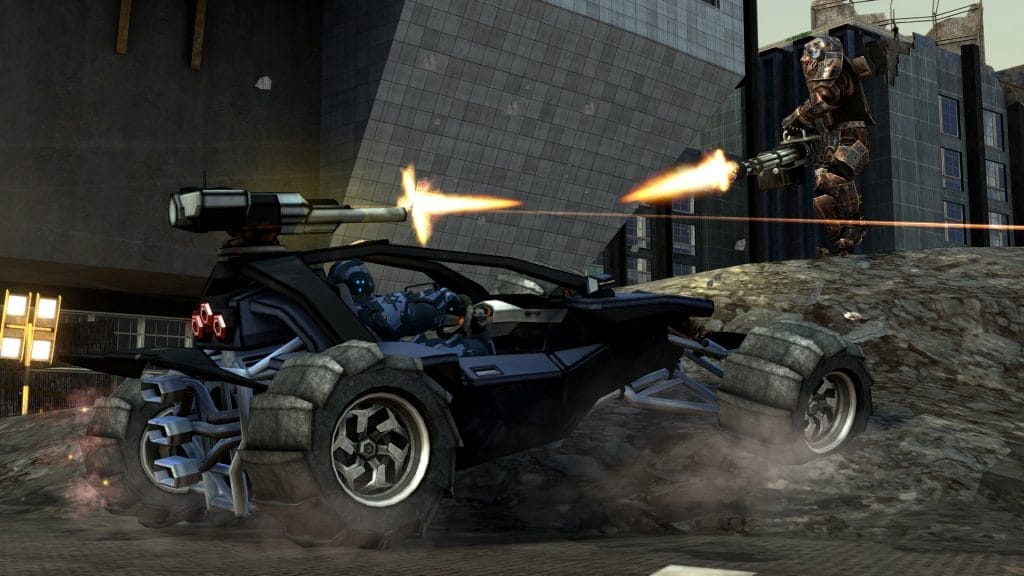
TechRaptor: It's okay! Since it comes out in about a month, I believe, how do you feel about the direction Crackdown 3 has taken, and its imminent release?
Sean: I haven't actually seen a ton about it. I've got a lot of friends who worked on it, actually. Like, a lot of the ex-Wheelman guys worked on it, obviously a lot of the ex-Crackdown 2 people worked on it, and a couple of other people I've worked with on other jobs since. Because it's in the UK and a lot of the UK has overlap. There's a lot of people I worked with that are still working on it. There's definitely still the same DNA in that, which is cool.
It's obviously weird to have been a part of a series at some point and then not be a part of it in the future, but that's happened a couple of times now. Yeah, I think it'll be cool. Obviously looking forward to seeing another Unreal game out there, especially an open world one. But I haven't seen much in the way of direction either way, at the moment. I'm aware that they've got two different modes with a single player and a multiplayer, but I don't know much outside of that right now.
TechRaptor: Perhaps your other big project that you worked on at Ruffian, that got shipped, was Kinect Star Wars. Is that like the childhood dream? One day you wake up and, hey, you're working on a Star Wars game.
Sean: So the rule of thumb in interviews is not to speak negatively about things, but I've got a point here. At the time, and this is kind of slightly off-topic but I think it's interesting, at the time I wasn't into Star Wars anymore. I kind of grown out of it. It wasn't just on me, a lot of friends, they grew up with it, we were all Star Wars nuts back then, I had the VHSes, I had a hell of a lot of the toys, I loved that stuff. I used to read the comics and everything. Then, as I got older, it's probably the prequels that did it, it just didn't seem cool to me anymore.
When the project came in I, obviously, I worked on it, but it wasn't something that excited me. Its quite strange to see what happened when Disney picked it up and made all these new ones and how cool it is to everyone now. It blows my mind a little bit because of that weird blip. It wasn't, it was only a couple years difference from when I worked on that to when Disney bought in and all of the other films came out.
But yeah, it's strange because I really did love the series as a child and then, as I grew older, I sort of fell out of love with it I guess, and then yeah. I think the new stuff is all great. But yeah, that was a weird project to work on. It was a quite short project though, I think I was only on it for a couple of months. I was basically doing background levels for the lightsaber fights. So I didn't have a very large impact on the game, I was just basically... not to say that background level design isn't needed. It was like I was working on a lot of other things at the same time.
It was an interesting experience because of what came from it. A hell of a lot of memes. It's always a good conversation starter.
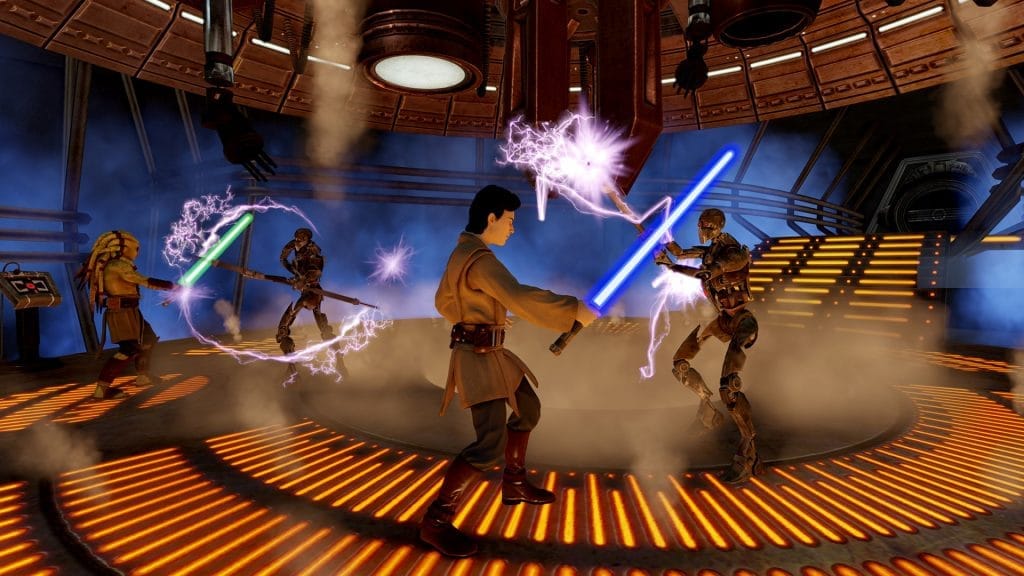
TechRaptor: I guess I better get this out of the way now. Did you have anything to do with the dancing mode?
Sean: Unfortunately not! That would have been great. That's not just a conversation starter, that's a conversation finisher. It's unfortunate that I wasn't part of that. I was aware that it was there. To this day I haven't actually played the final shipped game. I've only ever played it while testing. I don't know what it's like. I have it on a shelf, but I don't have a Kinect anymore.
TechRaptor: That's gotta be one interesting conversation when you tell someone you're personally responsible for Han Solo's dance moves.
Sean: [Laughter.] Yeah. That's... yeah. I'm jealous of whoever gets to say that.
TechRaptor: Speaking of the Kinect, how different is it working with... it's suddenly not players with a controller and using the right stick to move the camera, now they actually look around and interact. How different would you say, since you worked on background design, making sure the background worked with that?
Sean: The main thing, and this going to sound like I'm lazy, the main problem is that, to test the game, you have to leave your desk. So your... because the Kinect needs to see you and you need to respond to things. So say you're doing iterative changes. You change one thing, you have to stand up, do the whole log in thing, waving in front of the camera, and then seeing if the change worked, then sitting back down again and changing it again. That, I mean, people lose weight working on Kinect games, I can tell you that. Yeah, that's my real takeaway from working on a Kinect game, I think.
TechRaptor: Now before you went to Ubisoft, the last thing you worked on at Ruffian games is a prototype for an unfortunately never used Streets of Rage reboot. How do you guys sit down and go "how do we remake this classic franchise in a way that will appeal to people"?
Sean: Right, so that was a tough one. So that was an interesting project because it came from, again, contact I had from back in the Wheelman days. That's basically... it kind of came from there and the contract kind of appearing from that. It was quite a weird way that all came about.
At first I remember we were pitching it as a first-person game that was... we were going to lean into the 80's thing. At that point that wasn't really a thing. It was before the whole Kung Fury thing, and Blood Dragon and retro wave and all that kind of stuff. We had a few sort of, I would say taste makers, on the team that really wanted to push that. In fact, I remember the initial prototype that we built we were using Power Glove as the placeholder soundtrack which, as you may know, made the soundtrack for Blood Dragon a few years later.
So yeah, we were pitching it as a first-person game with a sort of retro feel. The first bit of feedback, before we really went to pitch it, was that "we don't want first-person," I think that may have been connected to the fact that Condemned was under the SEGA umbrella, and they weren't looking for anything too retro. So we took that back, took that feedback, and we went into something that a lot more people in the studio were passionate about, which was kind of the God of War series.
https://www.youtube.com/watch?v=z9TdeU9a8N8
We wanted to kind of see if we could merge the feel of the Streets of Rage series with the kind of mechanics you see in the God of War games. When I say the mechanics I'm being a bit liberal there, I'm basically talking about the scripted camera. What we wanted to do is-- we had this working. Unfortunately it's not in the prototype that was released, but we had scripted cameras that would actually pan side scrolling while you're fighting, like it looked like the game, and then, say you come across an alleyway as the camera pans along, the camera will then follow behind the character so you had a sort of third person view, or maybe elevates so you had this kind of cinematic view of the top where there's like enemies all around you, so you get a kind of Matrix whirley brawl sort of thing going on.Basically really leaning into the fact that the camera was a character and every so often having those moments that were more like the classic games.
But, unfortunately, that didn't really come across in the released video and I think we, obviously at this point the video was leaked, the game had already been canceled. So it didn't really matter, but the main feedback, and one of the main takeaways from people on forums and what-not, always say is that they wouldn't have wanted a sort of game that was that far removed. Unfortunately, we weren't actually that far removed from it, it's just the stuff that we chose to show to SEGA at that time, in that video, was a little safer, shall we say. Like showing something that was a bit more typical of the time, rather than showing the full extent of the camera system.
Yeah, it was great to be able to just live in that franchise for a little while, it was my life for a whirlwind romance of sorts with that IP, because, you know, I lived and breathed that for a while. It was a shame to see it get canceled, but yeah. Again, I think my work on that is basically what led me to moving on to my next gig on Watch Dogs.
TechRaptor: Now before we get to the Ubisoft years...
Next week I'll be talking to Sean about his solo indie game Jack B. Nimble, his time working at Ubisoft, the couple of years he spent at Foundry 42, and how he got the job as the lead level designer at Splash Damage.
Have a tip, or want to point out something we missed? Leave a Comment or e-mail us at tips@techraptor.net
